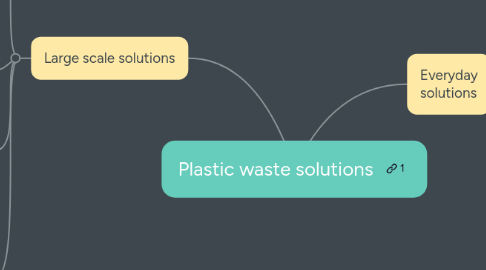
1. Everyday solutions
1.1. Millions are straws are used everyday and thrown away after one use
1.1.1. Use of metal straws
1.2. Plastic bags can harm wildlife such as marine organism
1.2.1. Use reuseable bags instead of
1.3. Plastic bottles are thrown away everyday after a single use
1.3.1. Carry a resusable bottle instead
1.4. Micro beads are small plastics which are in many cosmetic products: they can cause harm to aquatic organisms and are almost impossible to recover.
1.4.1. Avoid products with micro beads in it: opt for products which don;t contain them.
1.5. Buying prepared food, for example McDonald's, causes single use plastics to be used.
1.5.1. Instead prepare food at home and use of metal container to carry food.
1.6. Society has developed a "throwaway" culture. People buy cheap goods and throw them away when they are no longer required or suitable for use.
1.6.1. Encourage people to properly dispose of any damaged products.
1.6.2. Encourage people to buy better quality products, instead of the cheapest options e.g instead of a plastic bottle, buy a flask.
1.6.3. Impose a tax on companies which produce an excessive amount of single use plastics e.g companies which sell water in plastic bottles.
2. Large scale solutions
2.1. Plastics are finding their way into the oceans, causing large bodies of plastics to form and causes harm to aquatic wildlife.
2.1.1. Use of 'Boomy McBoomface' which is a prototype device
2.1.1.1. Inflatable boon which can collect plastics from the ocean to be recovered
2.1.2. Companies are mass producing plastics and turn a blind eye on the effect it has.
2.1.2.1. Taxes can be implemented making it less profitable to mass produce plastics.
2.1.3. Use of plastics are on the rise yet people have little incentive to recycle.
2.1.3.1. Use of recycling schemes where people are reimbursed with money for recycling.
2.1.3.2. Money can be saved on recycling routes if people take the material to recycling centers themselves.
2.2. Companies are producing mass amounts of plastic which can pollute the oceans and can affect the ecosystem.
2.2.1. Provide incentives to companies who use degradable materials.
2.2.1.1. Government contracts.
2.2.1.2. Tax breaks.
2.2.2. Impose heavy taxes on the mass production of non degradable plastics.
2.3. Provide funding and incentives for industrial companies to produce an alternative to plastics.
2.4. Single use plastic packaging is ending up in the oceans, despite being unnecessary.
2.4.1. Products can be sold in bulk, which limits the amount of plastic packaging used; some products should be packaged using different materials e.g flour is already packaged in paper packaging, why not coffee?
2.4.2. Development of the "edible water bubble" can end the sale of plastic bottles.
2.4.3. Biodegradable bottles can be made to combat plastic water waste.

